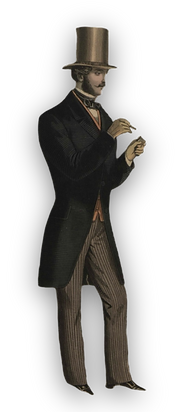
WELCOME TO
THE MERCHANT TAILOR MUSEUM
A comprehensive collection of men's garments produced between 1845 and 1865.
Historic tailoring research hub.
THE TAILORS' GUIDE
The Merchant Tailor Museum is excited to announce the
re-printing of Louis Devere and Charles Compaing's 1856
master work: The Tailors' Guide. For the first time in 167 years you can learn the art of pattern drafting using a true-to-the-original, two-volume pressing, copied directly from an original in the Museums' collection.
EXPLORE OUR COLLECTION
Browse through nearly 300 original men's garments and other artifacts, produced during one of the most pivotal periods in textile innovation and change. From "ready-made" frocks and flannel drawers, to high fashion silk waistcoats; get an in depth look at the styles, materials, and fits that made the man of the mid-19th century.



Our Mission
The mission of The Merchant Tailor Museum is the documentation of garments in our collection within the socio-economic context of their creation. The Museum conserves its collection to the highest standards of museum professionalism. Furthermore, the Museum highly prioritizes educational opportunities through radical public accessibility.

Accessibility
The Merchant Tailor Museum is founded on the concept of radical accessibility. As stewards of these important cultural resources, we feel that it's our responsibility to prioritize public access to the artifacts in our collection Accessibility and preservation are equally important facets of what we do.

Education
We share our educational resources through our detailed digital catalog, public engagement online and in person, workshops, research articles, and more. Education and accessibility go hand-in-hand, and we aim to serve as a proving ground for multidisciplinary approaches to artifact preservation and study.

Preservation
The responsible storage and treatment of the objects in our care, in alignment with the best practices of museum work, is as important as making them accessible to the public. Quality preservation practices are an indispensable requirement if these textiles are to be shared with future generations.

Educational Classes And Courses!
The Merchant Tailor Museum is not only dedicated to the preservation of the textiles within the collection, but also the trades and skills used in their creation. Learn the art of drafting and tailoring, measuring and cutting, and so much more!
Sign up for our email list to be notified of upcoming classes and courses. Click HERE to check out other educational resources.







